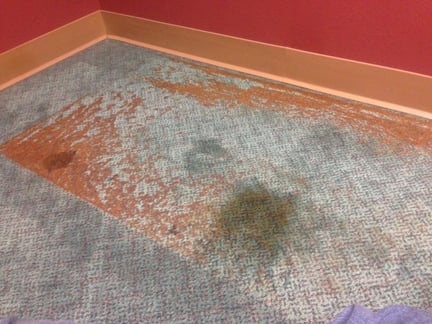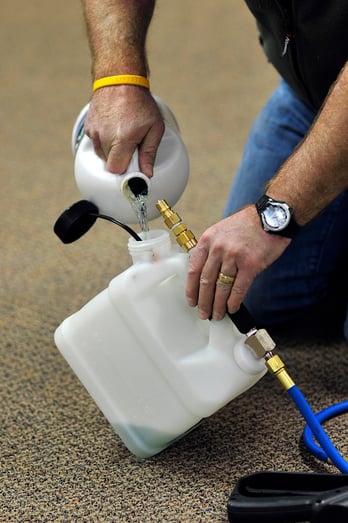Chemical & Physical reactions in Carpet Cleaning
Removing spots, spills and stains and separating soils from carpet fiber so the soil can be extracted involves both chemical and physical reactions. Cleaning technicians are often concerned about the pH of the cleaning agents they use. (A previous Tech Tuesday article discussed pH in some detail.) pH plays an important role in chemical reactions. However, most cleaning is accomplished by physical change. So, what is the difference between physical and chemical reactions?
Physical reactions don’t create new chemicals. Examples of physical reactions include melting ice to liquid water. The physical form is different, but the water is still water. Another example is dissolving salt in water. The salt and water are combined, but they did not change into anything different. The salt is still salt, and the water is still water. They could be separated and returned to the original form.
When a chemical reaction takes place, molecules of one kind change into molecules of something different. For examples, when you use acid rust remover to treat a stain, the rust is not actually removed. Instead, it is changed into something that is colorless, so the stain disappears. Oxidation and reduction are chemical changes used to remove many stubborn stains

-Before using T-Rust

-After using T-Rust
Dissolving
Many soils are water soluble. They dissolve in our cleaning water and can then be extracted. Our cleaning agents use chemistry such as surfactants to separate the soil from the fiber and to break these soils into very small pieces, which allows them to dissolve easier and faster.
Other soils including oils and grease can be dissolved in solvents other than water. The broad term is non-aqueous solvents. This includes chlorinated solvents and petroleum solvents.
Mixtures
Another type of physical change produces a mixture. An example would be mixing salt and sugar. They will mix together but the salt is still salt and the sugar is still sugar. Neither one has changed. No chemical reaction has taken place.
We know that water and oil don’t mix. Rather, they separate when combined. Emulsifiers break oily into small droplets and allow oils to disperse and remain suspended in water. Your favorite salad dressing likely contains an emulsifier to allow oil and water to mix.
Emulsifiers in our cleaning solutions allow solvents to mix with a water-based cleaning solution. Emulsifiers also help the dissolved oily soils to be suspended in water until they are extracted.
Most of the action of carpet cleaning involves the physical reactions of dissolving and emulsifying. Most soils are acid. The pH of alkaline cleaners neutralizes this acidity and plays a small role in these reactions.
When a chemical reaction occurs, something changes. It can be a change to the soil or stain we are trying to remove. A chemical reaction can also produce a change in the fiber or the dye we are trying to clean. Using physical change to clean is safer for the carpet and the technician.
pH and Chemical Reactions
Highly alkaline agents can combine with oily molecules to form soap. This is called saponification. Lye soap is an example. Highly alkaline lye is combined with animal fat to make soap. An alkaline prespray will combine with oils and grease in the carpet to form a basic type of soap. This rinses from the carpet easier than oil does.
pH is not the only thing that influences the strength of a chemical reaction. Some chemical reactions also require energy that can come from heat or light. Reactivity, total alkalinity and buffering come into play. What do these terms mean?
Reactivity
Some things react readily and some hardly react at all. Nitrogen and oxygen are the two main gases in our atmosphere. Nitrogen seldom reacts with anything. On the other hand, oxygen is quick to react. We probably see oxygen reacting with iron every day to create rust. This is one form of oxidation. Fire is an example of oxygen reacting with something very quickly. Energy in the form of heat and light are released. When oils oxidize, they turn yellow or brown and an oily stain becomes much more difficult to remove.
In addition to simply looking at the pH of a product, we should also think about how easily it reacts. If we only consider pH, a reaction might be more severe and damaging than we expect. The pH of a cola beverage is similar to the pH of an acid grout cleaner. The chemical reaction if you get them on your skin or ingest them are very different.
Oxidizers and reducers are formulated to be very reactive. They may create a chemical reaction that breaks down a staining agent or contamination into something that can be more easily rinsed away or they may change a stain to a colorless compound that cannot be seen. Other articles in this series have discuss the roles of oxidizers and reducers in greater detail.
Buffering
The pH of a cleaning solution can change rapidly when mixed with another chemical or when it reacts with soil in the carpet. The pH of some cleaning solutions remains very stable when diluted, mixed or reacting with soil.

Buffering describes the tendency of a chemical solution to resist a change in its pH. For alkaline cleaning products, buffering means that additional sources of alkalinity have been included as a “reserve.”
Consider two solutions with the same pH. One is buffered and has plenty of reserve alkalinity. The other is not buffered. Which do you think has more total alkalinity?
Total Alkalinity
A solution with low total alkalinity can “run out” of the ions that continue the chemical reaction. Then the reaction may slow down or stop. A solution with higher total alkalinity can sustain a chemical reaction. If the chemical reaction of your prespray stops too soon, dwell time is not helping, but a solution with higher total alkalinity continues to work at breaking down soil even with longer dwell times.
Is buffering a good thing? It depends. When cleaning wool, a buffered cleaning agent with plenty of total alkalinity can damage wool or dyes because any residue will not be easily neutralized but will remain highly alkaline. Wool is harmed by alkalinity, and the effect of alkalinity is greater over time.
When cleaning oily and greasy carpet, buffering means the solution will maintain its pH for greater saponification and break down more oils over a longer dwell time.
Key Points
The role of pH in cleaning products is often given undue attention. Reactivity, concentration, dilution, buffering and total alkalinity all influence the strength of a chemical reaction. Most cleaning is accomplished by physical reactions including dissolving, emulsifying and lubricating that allows soils to slide off the carpet fiber. Chemical reactions in cleaning are most often caused by rust removers and bleaches, either oxidizers or reducers. Effective cleaning results depend upon basics, including a chemical with good detergency, solvency, plus dwell time and agitation.
-Scott Warrington

